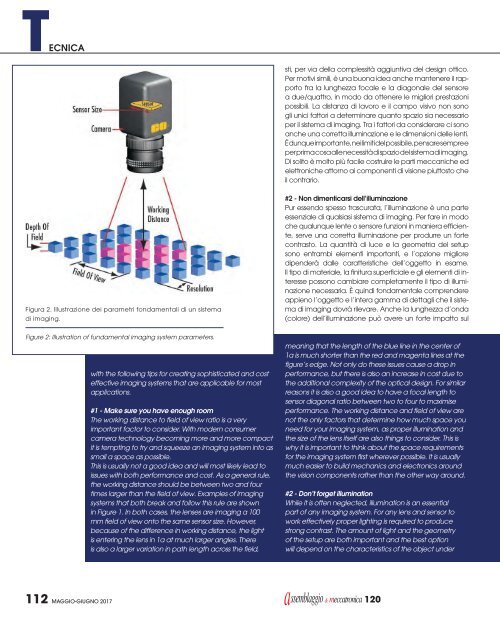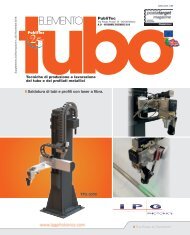AsseMec120_MAGGIU_2017
You also want an ePaper? Increase the reach of your titles
YUMPU automatically turns print PDFs into web optimized ePapers that Google loves.
TECNICA<br />
sti, per via della complessità aggiuntiva del design ottico.<br />
Per motivi simili, è una buona idea anche mantenere il rapporto<br />
fra la lunghezza focale e la diagonale del sensore<br />
a due/quattro, in modo da ottenere le migliori prestazioni<br />
possibili. La distanza di lavoro e il campo visivo non sono<br />
gli unici fattori a determinare quanto spazio sia necessario<br />
per il sistema di imaging. Tra i fattori da considerare ci sono<br />
anche una corretta illuminazione e le dimensioni delle lenti.<br />
Èdunqueimportante,neilimitidelpossibile,pensaresempree<br />
perprimacosaallenecessitàdispaziodelsistemadiimaging.<br />
Di solito è molto più facile costruire le parti meccaniche ed<br />
elettroniche attorno ai componenti di visione piuttosto che<br />
il contrario.<br />
Figura 2. Illustrazione dei parametri fondamentali di un sistema<br />
di imaging.<br />
#2 - Non dimenticarsi dell’illuminazione<br />
Pur essendo spesso trascurata, l’illuminazione è una parte<br />
essenziale di qualsiasi sistema di imaging. Per fare in modo<br />
che qualunque lente o sensore funzioni in maniera efficiente,<br />
serve una corretta illuminazione per produrre un forte<br />
contrasto. La quantità di luce e la geometria del setup<br />
sono entrambi elementi importanti, e l’opzione migliore<br />
dipenderà dalle caratteristiche dell’oggetto in esame.<br />
Il tipo di materiale, la finitura superficiale e gli elementi di interesse<br />
possono cambiare completamente il tipo di illuminazione<br />
necessaria. È quindi fondamentale comprendere<br />
appieno l’oggetto e l’intera gamma di dettagli che il sistema<br />
di imaging dovrà rilevare. Anche la lunghezza d’onda<br />
(colore) dell’illuminazione può avere un forte impatto sul<br />
Figure 2: Illustration of fundamental imaging system parameters.<br />
with the following tips for creating sophisticated and cost<br />
effective imaging systems that are applicable for most<br />
applications.<br />
#1 - Make sure you have enough room<br />
The working distance to field of view ratio is a very<br />
important factor to consider. With modern consumer<br />
camera technology becoming more and more compact<br />
it is tempting to try and squeeze an imaging system into as<br />
small a space as possible.<br />
This is usually not a good idea and will most likely lead to<br />
issues with both performance and cost. As a general rule,<br />
the working distance should be between two and four<br />
times larger than the field of view. Examples of imaging<br />
systems that both break and follow this rule are shown<br />
in Figure 1. In both cases, the lenses are imaging a 100<br />
mm field of view onto the same sensor size. However,<br />
because of the difference in working distance, the light<br />
is entering the lens in 1a at much larger angles. There<br />
is also a larger variation in path length across the field,<br />
meaning that the length of the blue line in the center of<br />
1a is much shorter than the red and magenta lines at the<br />
figure’s edge. Not only do these issues cause a drop in<br />
performance, but there is also an increase in cost due to<br />
the additional complexity of the optical design. For similar<br />
reasons it is also a good idea to have a focal length to<br />
sensor diagonal ratio between two to four to maximise<br />
performance. The working distance and field of view are<br />
not the only factors that determine how much space you<br />
need for your imaging system, as proper illumination and<br />
the size of the lens itself are also things to consider. This is<br />
why it is important to think about the space requirements<br />
for the imaging system first wherever possible. It is usually<br />
much easier to build mechanics and electronics around<br />
the vision components rather than the other way around.<br />
#2 - Don’t forget illumination<br />
While it is often neglected, illumination is an essential<br />
part of any imaging system. For any lens and sensor to<br />
work effectively proper lighting is required to produce<br />
strong contrast. The amount of light and the geometry<br />
of the setup are both important and the best option<br />
will depend on the characteristics of the object under<br />
112 MAGGIO-GIUGNO <strong>2017</strong> & meccatronica 120





